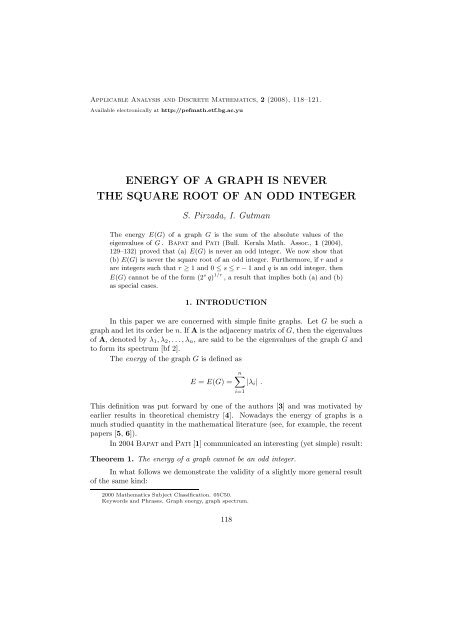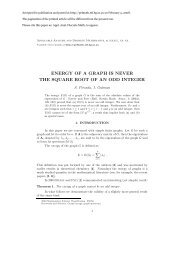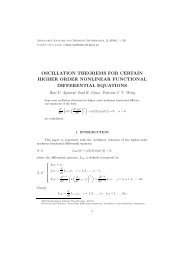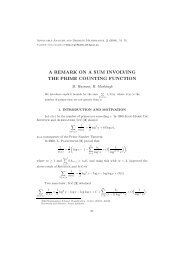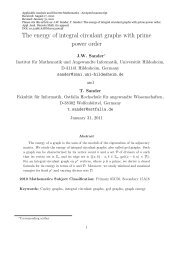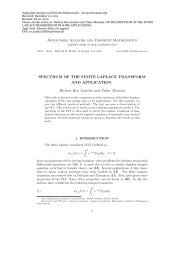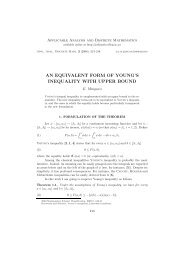ENERGY OF A GRAPH IS NEVER THE SQUARE ROOT ... - doiSerbia
ENERGY OF A GRAPH IS NEVER THE SQUARE ROOT ... - doiSerbia
ENERGY OF A GRAPH IS NEVER THE SQUARE ROOT ... - doiSerbia
You also want an ePaper? Increase the reach of your titles
YUMPU automatically turns print PDFs into web optimized ePapers that Google loves.
Applicable Analysis and Discrete Mathematics, 2 (2008), 118–121.<br />
Available electronically at http://pefmath.etf.bg.ac.yu<br />
<strong>ENERGY</strong> <strong>OF</strong> A <strong>GRAPH</strong> <strong>IS</strong> <strong>NEVER</strong><br />
<strong>THE</strong> <strong>SQUARE</strong> <strong>ROOT</strong> <strong>OF</strong> AN ODD INTEGER<br />
S. Pirzada, I. Gutman<br />
The energy E(G) of a graph G is the sum of the absolute values of the<br />
eigenvalues of G . Bapat and Pati (Bull. Kerala Math. Assoc., 1 (2004),<br />
129–132) proved that (a) E(G) is never an odd integer. We now show that<br />
(b) E(G) is never the square root of an odd integer. Furthermore, if r and s<br />
are integers such that r ≥ 1 and 0 ≤ s ≤ r − 1 and q is an odd integer, then<br />
E(G) cannot be of the form (2 s q) 1/r , a result that implies both (a) and (b)<br />
as special cases.<br />
1. INTRODUCTION<br />
In this paper we are concerned with simple finite graphs. Let G be such a<br />
graph and let its order be n. If A is the adjacency matrix of G, then the eigenvalues<br />
of A, denoted by λ 1 , λ 2 , . . .,λ n , are said to be the eigenvalues of the graph G and<br />
to form its spectrum [bf 2].<br />
The energy of the graph G is defined as<br />
E = E(G) =<br />
n∑<br />
|λ i | .<br />
This definition was put forward by one of the authors [3] and was motivated by<br />
earlier results in theoretical chemistry [4]. Nowadays the energy of graphs is a<br />
much studied quantity in the mathematical literature (see, for example, the recent<br />
papers [5, 6]).<br />
In 2004 Bapat and Pati [1] communicated an interesting (yet simple) result:<br />
Theorem 1. The energy of a graph cannot be an odd integer.<br />
In what follows we demonstrate the validity of a slightly more general result<br />
of the same kind:<br />
i=1<br />
2000 Mathematics Subject Classification. 05C50.<br />
Keywords and Phrases. Graph energy, graph spectrum.<br />
118
Energy of a graph is never the square root of an odd integer 119<br />
Theorem 2. The energy of a graph cannot be the square root of an odd integer.<br />
In order to prove Theorem 2 we need some preliminaries.<br />
2. PRELIMINARIES<br />
Using the terminology and notation from the book [2], we define two operations<br />
with graphs.<br />
By V (G) and E(G) are denoted the vertex and edge sets, respectively, of the<br />
graph G.<br />
Let G 1 and G 2 be two graphs with disjoint vertex sets of orders n 1 and n 2 ,<br />
respectively.<br />
The product of G 1 and G 2 , denoted by G 1 × G 2 , is the graph with vertex<br />
set V (G 1 ) × V (G 2 ) such that two vertices (x 1 , x 2 ) ∈ V (G 1 × G 2 ) and (y 1 , y 2 ) ∈<br />
V (G 1 × G 2 ) are adjacent if and only if (x 1 , y 1 ) ∈ E(G 1 ) and (x 2 , y 2 ) ∈ E(G 2 ).<br />
The sum of G 1 and G 2 , denoted by G 1 + G 2 , is the graph with vertex set<br />
V (G 1 )×V (G 2 ) such that two vertices (x 1 , x 2 ) ∈ V (G 1 +G 2 ) and (y 1 , y 2 ) ∈ V (G 1 +<br />
G 2 ) are adjacent if and only if either (x 1 , y 1 ) ∈ E(G 1 ) and x 2 = y 2 or (x 2 , y 2 ) ∈<br />
E(G 2 ) and x 1 = y 1 .<br />
The above specified two graph products have the following spectral properties<br />
(see [2], p. 70).<br />
Let λ (1)<br />
i , i = 1, . . .,n 1 , and λ (2)<br />
j , j = 1, . . . , n 2 , be, respectively, the eigenvalues<br />
of the graphs G 1 and G 2 .<br />
Lemma 1. The eigenvalues of G 1 × G 2 are λ (1)<br />
i λ (2)<br />
j , i = 1, . . .,n 1 ; j = 1, . . . , n 2 .<br />
Lemma 2. The eigenvalues of G 1 +G 2 are λ (1)<br />
i +λ (2)<br />
j , i = 1, . . .,n 1 ; j = 1, . . .,n 2 .<br />
The eigenvalues of a graph are zeros of the characteristic polynomial and the<br />
characteristic polynomial is a monic polynomial with integer coefficients. Therefore<br />
we have:<br />
Lemma 3. If an eigenvalue of a graph is a rational number, then it is an integer.<br />
3. PRO<strong>OF</strong> <strong>OF</strong> <strong>THE</strong>OREM 2<br />
Consider a graph G and let λ 1 , λ 2 , . . . , λ m be its positive eigenvalues. Then<br />
in view of the fact that the sum of all eigenvalues of any graph is equal to zero<br />
E(G) = 2<br />
m∑<br />
λ i .<br />
i=1<br />
Denote λ 1 + λ 2 + · · · + λ m by λ. By Lemma 1 λ is an eigenvalue of some graph H<br />
isomorphic to the sum of m disjoint copies of the graph G. By Lemma 2 λ 2 is an<br />
eigenvalues of the product of two disjoint copies of the graph H.
120 S. Pirzada, I. Gutman<br />
Suppose now that E(G) = √ q, where q is some integer. Then 2 λ = √ q, i.e.,<br />
λ 2 = q/4. If q would be an odd integer, then q/4 would be a nonintegral rational<br />
number in contradiction to Lemma 3.<br />
Theorem 2 follows.<br />
□<br />
We have an immediate extension of Theorem 2:<br />
Observation. The energy of a graph cannot be the square root of the double of an<br />
odd integer.<br />
However, this observation is just a special case of a somewhat more general<br />
result.<br />
4. GENERALIZING <strong>THE</strong>OREM 2<br />
Let H be the same graph as in the preceding section. Thus λ an eigenvalue<br />
of H. Let H ∗ be the product of r disjoint copies of H. Then by Lemma 2 λ r is an<br />
eigenvalue H ∗ .<br />
Suppose now that E(G) = q 1/r , where q is some integer. Then 2 λ = q 1/r ,<br />
i.e., λ r = q/2 r . If q would not be divisible by 2 r , then λ r would be a nonintegral<br />
rational number in contradiction to Lemma 3. Therefore we have:<br />
Theorem 3. Let r and s be integers such that r ≥ 1 and 0 ≤ s ≤ r − 1 and q be<br />
an odd integer. Then E(G) cannot be of the form (2 s q) 1/r .<br />
For r = 1 and s = 0 Theorem 3 reduces to Theorem 1. For r = 2 and s = 0<br />
Theorem 3 reduces to Theorem 2. The Observation pertains to r = 2 and s = 1.<br />
REFERENCES<br />
1. R. B. Bapat, S. Pati: Energy of a graph is never an odd integer. Bull. Kerala Math.<br />
Assoc., 1 (2004), 129–132.<br />
2. D. Cvetković, M. Doob, H. Sachs: Spectra of Graphs – Theory and Application.<br />
Academic Press, New York, 1980; 2nd revised ed.: Barth, Heidelberg, 1995.<br />
3. I. Gutman: The energy of a graph. Ber. Math. Statist. Sekt. Forshungsz. Graz, 103<br />
(1978), 1–22.<br />
4. I. Gutman, O. E. Polansky: Mathematical Concepts in Organic Chemistry. Springer–<br />
Verlag, Berlin, 1986.<br />
5. H. Hua, M. Wang: Unicyclic graphs with given number of pendent vertices and minimal<br />
energy. Lin. Algebra Appl., 426 (2007), 478–489.<br />
6. V. Nikiforov: Graphs and matrices with maximal energy. J. Math. Anal. Appl., 327<br />
(2007) 735–738.
Energy of a graph is never the square root of an odd integer 121<br />
Department of Mathematics, (Received October 6, 2007)<br />
University of Kashmir,<br />
Srinagar,<br />
India<br />
E-mail: sdpirzada@yahoo.co.in<br />
Faculty of Science,<br />
University of Kragujevac,<br />
Kragujevac,<br />
Serbia<br />
E-mail: gutman@kg.ac.yu


